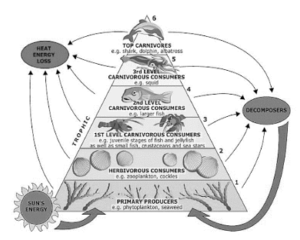Energy is transferred from plants to herbivores, then to carnivores, in the grazing food chain. The detritus food chain, on the other hand, entails the transfer of energy from dead plants and animals to detritivores, who then pass it along to other creatures.
Because it involves the transfer of energy from one living thing to another, the grazing food chain is usually more efficient. The detritus food chain, on the other hand, is less efficient due to the energy transfer from deceased plants and animals to other creatures.
Difference between Grazing and Detritus Food Chain
Parameters | Grazing Food Chain | Detritus Food Chain |
Definition | Green plants serve as the principal source of energy in a grazing food chain. | The fundamental source of energy for a detritus food chain is the dead remnants of creatures. |
Energy Source | In a grazing food chain, solar energy is the primary source of energy. | The dead leftovers of plants and animals are the principal source of energy for the detritus food chain. |
Organisms Involved | The grazing food chain includes all macroscopic and subsoil creatures. | Microscopic creatures dominate the Detritus Food Chain. |
Importance | The grazing food chain is a source of energy for the ecosystem. | The detritus food chain absorbs a lot of energy from the environment. |
First Trophic Level | In the grazing food chain, green plants are the lowest trophic level. | Inside the grazing food chain, green plants are the lowest trophic level. |
Subdivision of Grazing Food Chain
Predator Chain: The photosynthetic organisms are eaten by primary consumers (fish, insects), and the primary consumers are devoured by secondary consumers in a predator cycle.

Parasitic Chain: The parasitic chain is a sort of grazing food chain in which parasites such as fungus impact photosynthetic organisms and consumers.

Examples of Detritus Food Chain
Dead Organic Matter → Microorganism → Decomposers
The degradation of plants and animals starts the food chain, which is then devoured by microbes like bacteria and fungi. Decomposers like snails and earthworms consume these microbes, which are then eaten by larger animals.
Leaves → Insect Larvae → Fishes → Larger predators
The mangrove tree’s leaves are the start of the food chain. Phytophagous — plant-eating insects – devour only about 5% of the leaves of a red mangrove tree that fall into a shallow water body before they fall. Insect larvae, crabs, copepods, and other small critters consume sections of the leaves. Carnivorous fishes ingest these organisms later. Eventually, larger fish or fish-eating birds consume these fish.
Conclusion
In the grazing food chain, energy is transported from plants to herbivores, then to carnivores. On the other hand, the detritus food chain involves the transfer of energy from dead plants and animals to detritivores, who then pass it on to other organisms.The grazing food chain is usually more efficient since it involves the transfer of energy from one living creature to another.
 Profile
Profile Settings
Settings Refer your friends
Refer your friends Sign out
Sign out






